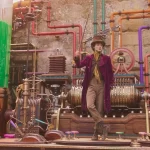Spoonful of Sugar, by Tyler Smith
On the surface, John Lee Hancock’s Saving Mr. Banks appears to be fairly simplistic. Characters often say what they mean and there are clear lines from motivation to action. It always seems obvious as to what is going on, both through the use of declarative statements and on-the-nose flashbacks. So why did I respond so positively towards the film?
Perhaps because, for everything that is said outright, there are several things that go unsaid; they are only hinted at. The film does acknowledge the wounds of its characters, but somberly nods at an even deeper pain. It reminds me of those people that share just enough about themselves to give the impression that they’re being open, but you can tell that there is a wellspring of hurt just under the surface.
Not to imply that the film is being purposely disingenuous. I think Hancock knows very well what he is doing, but chooses not to over-emphasize it. Which is why close attention needs to be paid to tossed-off lines and brief glances. When we look closer, we see an ensemble of characters that each have pasts (and, in some cases, presents) filled with pain and loss. Each person responds to this in their own way. Perhaps they try to repress it, or are overly cheerful, or maybe just angry. The method is different, but the motivation is the same.
P.L. Travers has chosen to deal with the pain of a sad childhood by closing herself up emotionally, clinging to the one escape she has provided herself: her books. Through her writing, she has created a world that provides hope where there seems to be none. And while she has made this escape public, it becomes clear over the course of the film that she views it first and foremost as hers. Others may enjoy it, but that is incidental.
Enter Walt Disney, who made a promise to his daughters twenty years prior that he would bring Travers’ creation, Mary Poppins, onto the big screen. Disney is canny and manipulative, a mix of genuine down-home optimism and business savvy. As observed by Travers, Disney has grown very accustomed to getting his way. The character, while likable, is not wholly sympathetic. We have the benefit of hindsight, knowing that the final film essentially worked out exactly the way Disney wanted it, despite Travers’ objections.
And yet even Disney is not dismissed outright. We assume at the beginning that his discussion of the promise to his daughters is a card he is playing, trying to play on Travers’ sympathy. But when we hear Disney’s own tale of childhood woe- and the father that pinched every penny and instilled an almost abusive work ethic in his boys- things start to fall into place. Yes, maybe Disney is using his daughters as emotional leverage, but perhaps he is genuinely distressed that he will let them down, as he was so often let down himself.
In both Travers’ and Disney’s cases, we see two people that have devoted their lives to either correcting or escaping from the pain of the past. Neither can be said to necessarily be the “right” way. Travers’ solution means cutting herself off from others emotionally, while Disney’s requires that he constantly insist on his own way, trampling others in the process.
These are complex themes that can give the audience pause. How are we handling our own pain? Are we handling it? Hard questions, especially from a film with as much polish and audience-friendly sheen as Saving Mr. Banks. But maybe that’s the idea. As we settle in to watch a seemingly simple story about two notable personalities and the making of a family classic, we are met with something much more troubling. And yet the film never ceases to be family-friendly and glossy. Maybe that is the proverbial “spoonful of sugar” to help the medicine go down.































You know, after this review, I might just go see this.